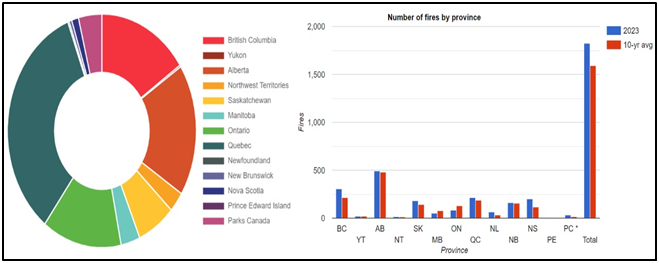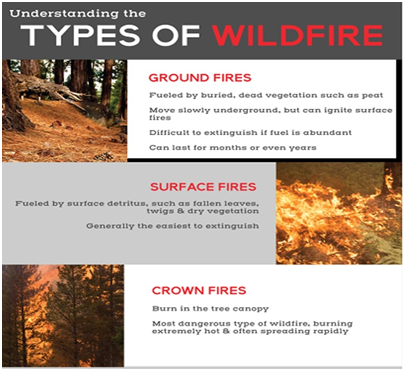Why in news?
- New York City’s air quality is currently ranked among the worst in the world due to drifting smoke rising from wildfires in Canada.
- According to the Canadian Interagency Forest Fire Centre, there are 426 active fires in the country as on June 8, 2023.
- Out of these, 232 were reportedly out of control. A major chunk of these — 144 — were reported from Quebec province alone.
What’s in today’s article?
- Forest Fires/Wildfires – About, cause, types
- Wildfires in Canada
- Lightning phenomena
What are Forest Fires/Wildfires?
- Meaning: It is an unplanned, uncontrolled and unpredictable fire in an area of combustible vegetation.
- Causes: These include natural (lightning, high atmospheric temperatures and low humidity (dryness) and man-made (agricultural practices like Jhum, a source of fire (cigarette, bidi, etc)].
- Types of forest fire:
What is causing the wildfires in Canada?
- Lightning as a major cause
- Most of these forest fires have been caused by lightning.
- Laboratory experiments and field observations have indicated that continuing electrical currents in lightning flowing for more than some tens of milliseconds (so-called Long-Continuing-Currents, or LCC) are likely to produce fires.
- An estimated increase of LCC lightning over land increases the risk of lightning-ignited wildfires.
- Human activities are also to be blamed for adding to the forest fires.
- Other reasons
- As per analysts, Atlantic Canada received low snowfall this winter, followed by an unusually dry spring.
- The weather of Nova Scotia province, where wildfires are not unusual but fewer than in other provinces, is influenced by the North Atlantic Ocean.
- Due to its proximity to the ocean, the region ordinarily has higher humidity and more moderate temperatures as compared to many other parts of the country.
- This year, Nova Scotia’s capital Halifax received just 120 millimetres of rain between March and May, roughly a third of the average. To add to the region’s woes, a late-May heat wave pushed the temperature up.
International effort to fight wildfires in Canada
- U.S. President Biden announced that the country has sent more than 600 U.S. firefighters, support personnel, and firefighting assets to Canada since May.
- The European Commission announced that a total of 280 firefighters from France, Portugal, and Spain will be travelling to Canada to help put out the fires under the European Union’s Civil Protection Mechanism.
- The European Union’s Civil Protection Mechanism is a framework designed to facilitate cooperation among member states in responding to disasters, both within the European Union and internationally.
- It aims to enhance the effectiveness of disaster management by enabling countries to assist each other in times of crisis.
- Help for Canada has also come from South Africa, Australia, and New Zealand.
How does lightning work?
- During a storm, water droplets from warmer air and ice crystals from cooler air come together to form thunderstorm clouds.
- Contact between these water droplets and ice crystals produce a static electrical charge in clouds.
- When opposing negative and positive charges in clouds build up, the insulating capacity of air between the charges as well as between the cloud and the ground breaks down, leading to a rapid discharge.
- This is what is called lightning. It can occur between opposite charges within the thunderstorm cloud, or between opposite charges in the cloud and on the ground.
Lightning an indicator of climate change
- The World Meteorological Organisation recognises lightning as an essential climate variable that critically contributes to the characterisation of the earth’s climate.
- As global warming increases, the earth’s surface temperature, lightning activity also predicted to increase.
- As per different scientific literatures, lightning also produces nitrogen oxides. These react with other gases in the atmosphere and produce ozone- a greenhouse gas.
- Ozone is a strong greenhouse gas that traps earth’s outgoing heat and retains it in the atmosphere, altering climate and weather patterns.






